In 1998, the 400th anniversary of the founding of Albuquerque by Spanish conquistadors, the city commissioned a monument to be placed in front of the Albuquerque Museum. The process was highly contentious. Although over the centuries Spanish and Native blood has mixed, consensually and otherwise, a challenge like how to memorialize colonization can send people into corners where the other – even the other part of you – becomes the enemy.
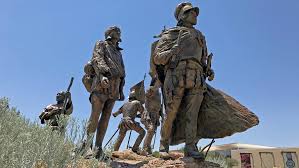
The solution in the end was to have two separate, adjacent monuments. La Jornada is a procession of thirty-three bronze figures in a kind of diorama depicting the arrival of the Spanish. Don Juan de Oñate, the controversial founder of Albuquerque, in helmet and armor, led the procession — until he was removed in June 2020 following a night of violence over his fate. (Oñate was the target of protests on behalf of Native Americans for his role as a cruel conqueror who cut off the left foot of dozens of young Acoma Pueblo men in retribution for the killing of a soldier.) The rest of La Jornada remains in place, a priest, a scout, men, women and children settlers, herders, an ox cart, and livestock.
Nora Naranjo Morse, poet and artist from Santa Clara Pueblo, was given an area fifty yards or so to the west for her own creation, Numbe Whageh, or Pueblo Center Place. She chose to leave the land natural and to carve a simple spiral foot path leading to a low point in the landscape, below ground level of the museum and La Jornada. At the bottom she added a small water feature, barely more than a trickle running over a smooth flat rock. Water-loving plants grew up creating a small oasis, treasured on a hot Albuquerque day. Morse’s poetic plaque introducing the natural installations speaks of the clouds and mountains, the thunder and lightning, the winds from four directions, the plants, animals, and life-giving water.
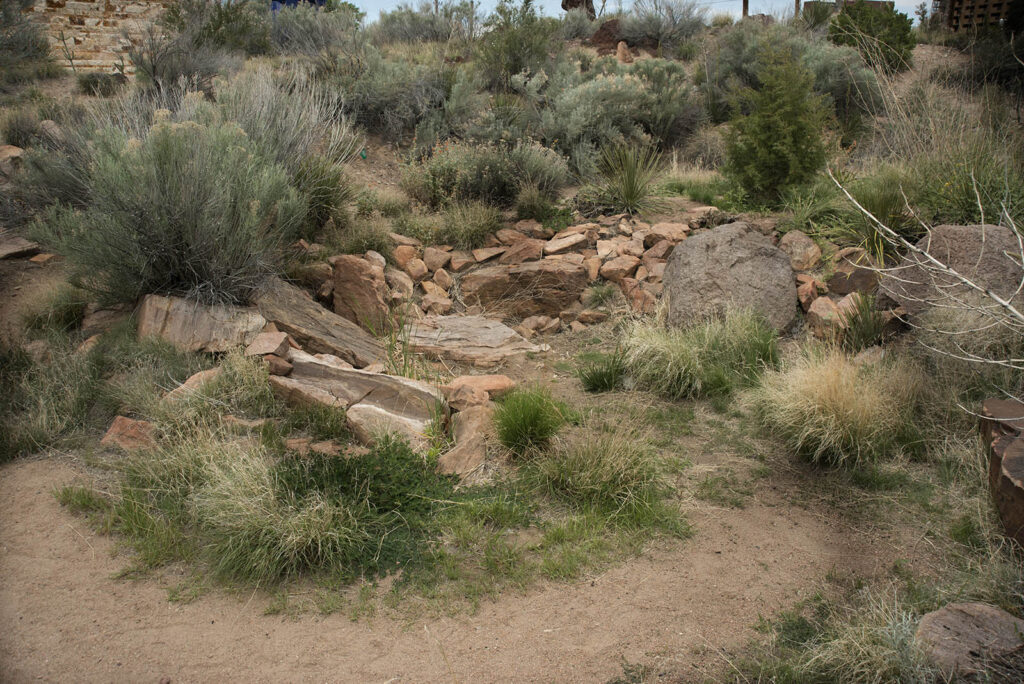
I visited the two monuments recently as one of a diverse group of facilitators who facilitated a series of city-sponsored conversations, part of the city’s Race, History and Healing Project. The Mayor’s goal is to begin a cultural and racial healing process for the City and ultimately to resolve the current dispute over the future of Oñate, now in safe keeping, and La Jornada. (Our role is over for now but we are hopeful that the conversations which involved hundreds of citizens and were very powerful, will continue.)
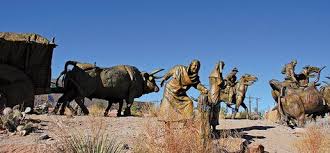
I walked around the La Jornada Monument, mounted on a long rock uprising. I looked up at the figures, the wagon, the animals, all life-size, in poses natural for travelers on foot and horseback. They are moving northward on their journey, equipped with weapons, religion, livestock, families with children. Around the base on one side is a row of dozens of plaques with the names of the 600 people, the Founding Families who traveled with Oñate. I saw many surnames of friends, some who identify Hispanic, some Native. The monument left me with a sense of the confidence and determination, of these colonists as they moved into foreign lands, and the pride that their descendants must feel.
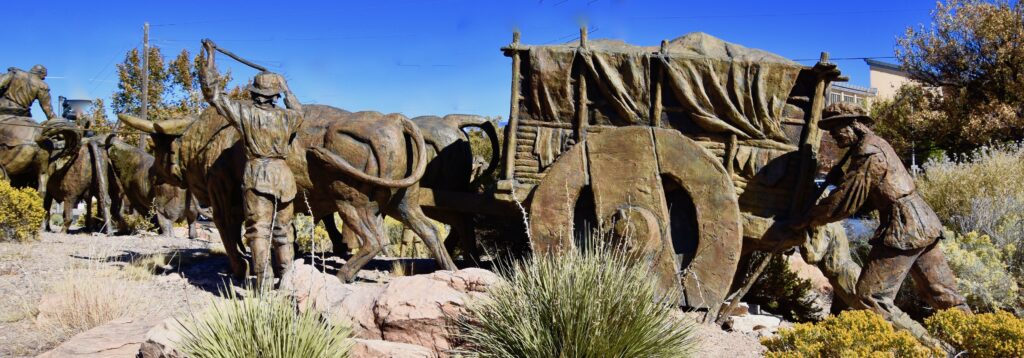
I moved away from La Jornada and found the plaque at the entrance to Numbe Whageh. I descended the spiral path to the center, the representation of the origin place for some of the Pueblo people. Trickling water flowed over the rock. Someone had placed an offering of small round pebbles nearby. Other than that there was no sign of a human hand. A road runner scooted by. A butterfly lit on a Penstamen. The land, soil, plants, rocks were as they might have been back in 1598.

I looked up and out, above ground level and could see in the distance the bronze caravan making its way north. Was this what a Native might have seen, might have heard in those early years of colonization? Looking up, through the Rabbit Brush and Chamisa, could she imagine the future? Adjusting to new neighbors – not just the Spanish, but waves of other immigrants through the centuries — Native life for many would change radically over the next 400 years. The cultures of many would remain remarkably strong. The natural world would suffer, in time, deeply.
Numbe Whageh spoke to me of the profound loss for Native people and the preciousness of what remains. In La Jornada I recognized the spirit of discovery and conquest, human qualities for which we all pay a price as well as reap benefits.
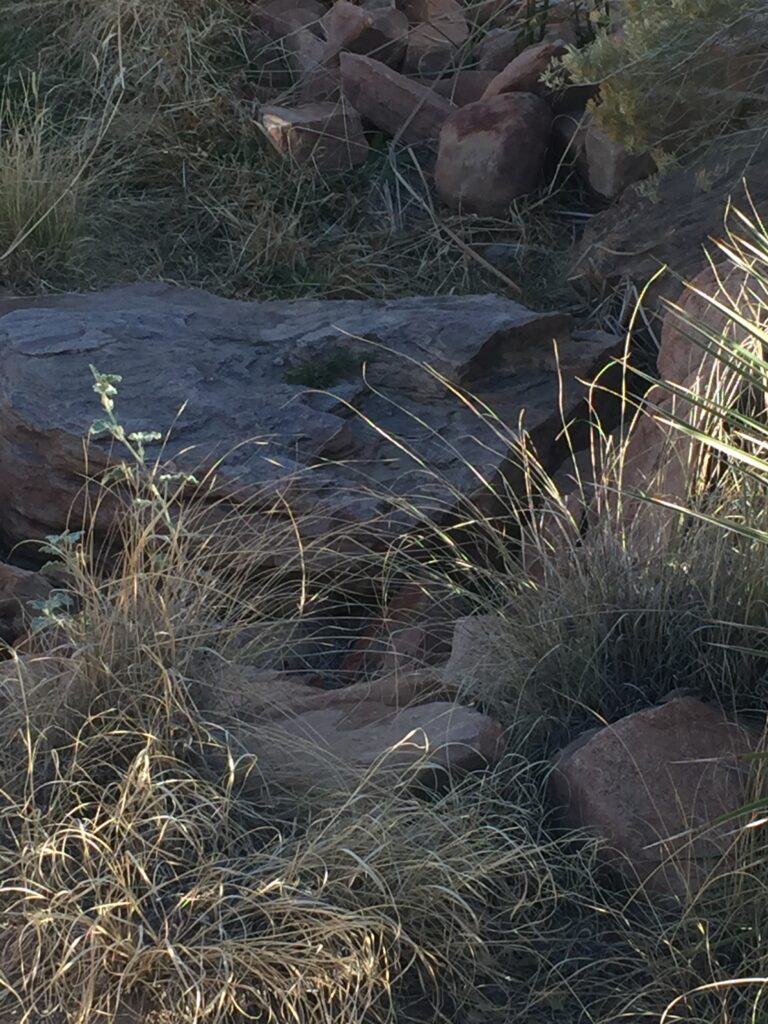
above, water trickling at bottom of Numbe Whageh
The two monuments, side by side, say it all.
below, one of dozens of plaques with names of those founding families who came with Oñate
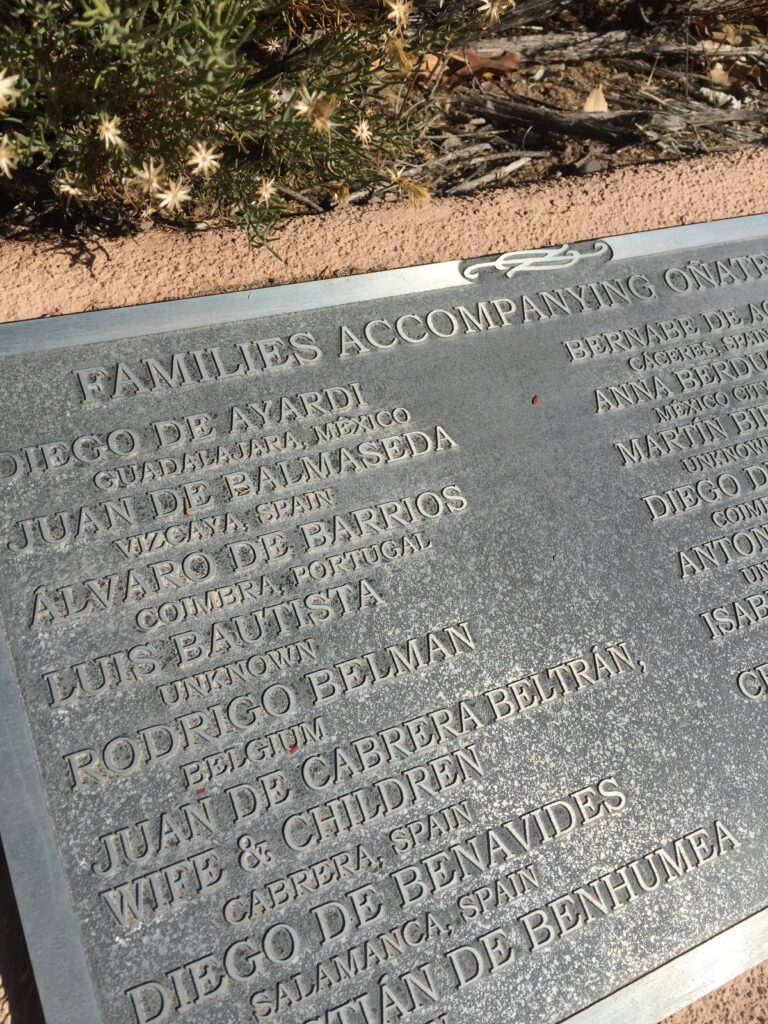

Great blog and history lesson! Impressive that the two monuments are “side by side”. What it says to me is ; recognize and accept our past with all its faults, but look above the low spots in our history to what we can do to make life better for all. True equality is not realistic, but striving for ways we can make sustain a pluralistic society should be our goal. Thank you for sharing your knowledge and experience.
Thanks, Larry. I like your goals, both aspirational and realistic.
I come from American Pioneers myself. 300 years ago they were settling the Cumberland Valley in Tennessee and Kentucky. They were still there during the Civil War only moving west afterwards. Davy Crockett was in there. So was Mary Walker, a civil war surgeon. I have been proud of my pioneer ancestors–tough, persevere, make do, etc. I am not proud of the way the native americans were treated , but there is nothing in My history that says we had slaves or anything like that. they were just people trying to scrape out a life along with a whole lot of other people . Immigrants are just people who are migrating.
I appreciate your “taking this personally,” and it’s interesting to learn a bit about your ancestry. I think that is an important result of these difficult moments that challenge the status quo — we look at our own histories and our current roles. Whether or not our people owned slaves, today we are part of a country with that shameful past and need to take responsibility for healing. Thanks, Linda.
Lucy, what a deeply caring, thoughtful and insightful reflection. I knew about La Jornada and Onate monuments but did not know about Numbe Whageh. Just so simple, profound, lovely. I will be sure to visit it the next time I am in Santa Fe!
Meanwhile, just hunkering down and engaging with life online. So weird! But for now it works and makes it possible for us to continue doing what needs to be done. Myself I am volunteering with the Middle Rio Grande Water Advocates, the New Mexico Paddlers Coalition, walking in the Sandias, and making art. I am enthusiastic about my latest artworks, which have taken a long time arriving! Nonetheless they are almost finished. I will send photos one of these days soon. Meanwhile, lets all celebrate a new era and hope for the best with the new team in DC. Glad it’s not my job! ; /
Thanks, Laurie and you don’t need to come to Santa Fe to see the monuments — they are in front of the Albuquerque Museum!
fascinating juxtaposition, these two monuments, one so elaborate, the other so simple. Your glimpse of one from the other depicting a moment in time so unforgettable, so life-changing! This was a very real moment, all over the West.
I hope you can spend some time with these two memorials — it’s really powerful.